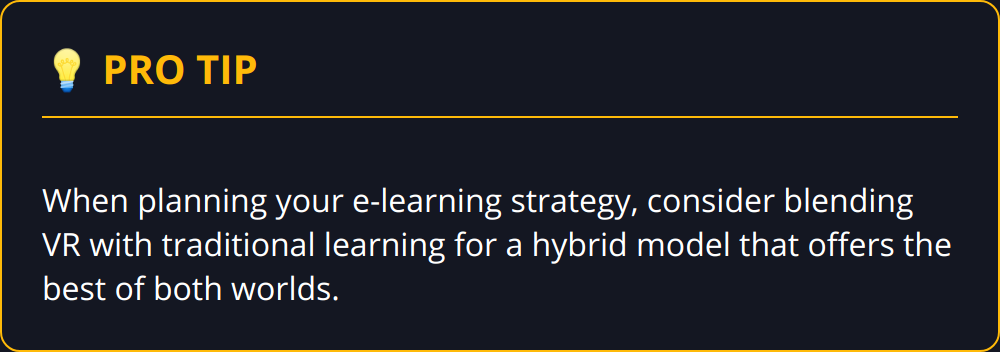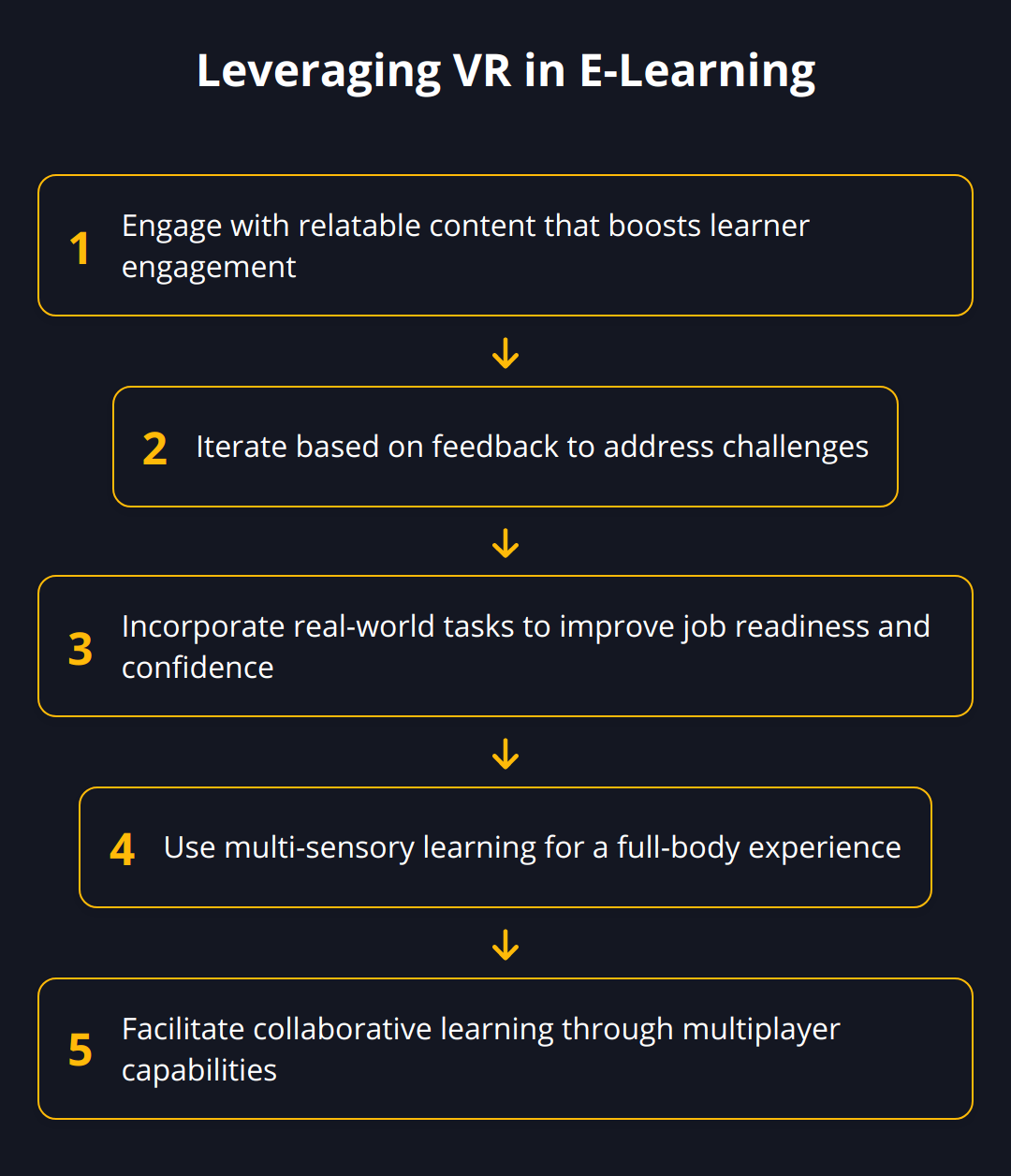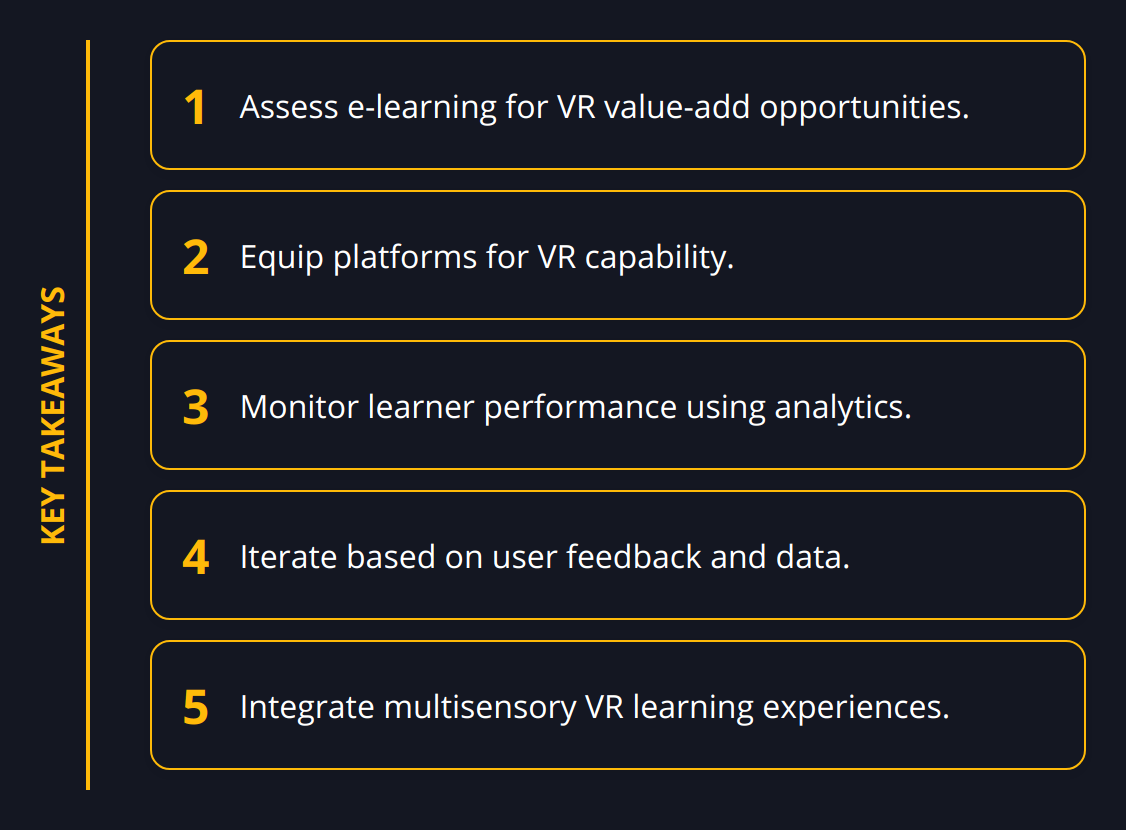The fusion of Virtual Reality (VR) with e-learning is rapidly transforming the educational landscape, introducing new dimensions of interactivity and immersion. At Newroom Connect, we have seen firsthand how VR’s engaging potential revolutionizes learning outcomes. This integration isn’t just a fleeting trend; it’s a profound shift in the way knowledge is imparted and experienced. Through our guide, we aim to navigate you through the reality of immersive learning, its current applications, and the strategies for effectively embedding VR into your e-learning initiatives.
Why Integrate VR in E-Learning?
The integration of Virtual Reality technology in e-learning platforms marks a strategic advancement in educational methods. Immersive learning experiences are no longer futuristic concepts but are being harnessed today to deliver impressive educational outcomes. Learning through VR offers a bridge between theories and real-life application, providing learners a chance to engage with content on a visceral level. This isn’t merely engaging—it’s transformative.

Robust data back up the push towards VR in education. A PwC report found that learners in VR courses can be up to four times more focused than their e-learning peers and could be trained up to four times faster. In practice, this means that not only can educational institutions deliver content more efficiently, but also ensure the knowledge is retained and applied more effectively.
Several e-learning platforms are beginning to incorporate VR to offer learners a comprehensive immersive experience. Platforms leverage VR to simulate realistic scenarios where learners can practice skills ranging from surgery to public speaking without the risk and anxiety associated with real-world failures. Moreover, platforms incorporating VR show a significant increase in learner engagement and satisfaction.

Here are actionable insights into VR integration for your e-learning initiatives:
-
Assess your current e-learning strategy for opportunities where VR can add value. Simulation-based learning or complex problem-solving scenarios are excellent starting points.
-
Equip your platforms with VR capabilities. Whether it’s standalone VR headsets or more sophisticated setups, make sure you have the hardware to support your VR endeavours.
-
Focus on creating VR content that complements your e-learning objectives. If you’re involved in medical training, a VR module on anatomy can offer a 3D interactive learning experience that outmatches any textbook illustration.
-
Monitor and evaluate learner performance within the VR environment. Use built-in analytics tools to glean insights about user engagement and knowledge retention.
-
Keep abreast of VR learning space trends to stay ahead in the rapidly evolving e-learning landscape.
By embracing VR, educators are not merely adopting new technology—they are pioneering an educational revolution that caters to the needs of the digital generation. It’s imperative to recognize the need for continuous innovation within e-learning platforms, and integrating VR is an assertive step in that direction. The goal is no longer just to inform but to immerse, engage, and empower learners like never before.
How Does VR Benefit E-Learning?
Virtual Reality in e-learning is not just a gimmick—it’s a game-changer that brings demonstrable gains in learner engagement and knowledge retention. When learners are absorbed in a VR setting, they’re partaking in a level of interactivity that traditional e-learning can’t match. The immersion afforded by VR results in a vivid learning experience that sticks.

One key aspect where VR outshines traditional methods is learner retention. With VR, learners can achieve an impressive retention rate of up to 75% according to the National Training Laboratories. This starkly contrasts with the 5% retention rate for lecture-based learning, making VR an undeniably powerful tool for educational purposes.
Moreover, VR enables the safe simulation of complex scenarios. For instance, medical students can perform virtual surgeries, explore human anatomy in 3D, or manage emergency room protocols without the life-or-death pressure. These rich, risk-free environments encourage trial and error, a cornerstone of deep learning.

Let’s focus on interactive and personalized learning journeys. Each learner can follow their own path within a VR environment, progressing at their own pace and revisiting concepts as needed. For example, language learners can practice conversations in a multitude of realistic scenarios. This tailoring of the learning pathway is not just flexible; it’s also highly effective.
Here are some practical steps to leverage VR for enhancing e-learning experiences:
-
Engage with relatable content: Create scenarios and simulations that are directly tied to the learner’s field or interest to boost engagement.
-
Iterate based on feedback: Gather user data and adjust VR experiences to address common challenges or stumbling blocks.
-
Incorporate real-world tasks: Design simulations that mirror tasks learners will encounter on the job, thus improving their readiness and confidence.
-
Incorporate multi-sensory learning: Use VR’s ability to incorporate visual, auditory, and even haptic feedback to create a full-body learning experience.
-
Facilitate collaborative learning: Make use of VR’s multiplayer capabilities to foster teamwork and communication skills through shared virtual experiences. The benefits of virtual trade fairs include networking, and similar principles can be applied in learning environments.

Overall, integrating VR into e-learning courses proves not just a smart move, but a necessary evolution in education to cater to modern learning preferences and requirements. With VR, we’re not just peaking learners’ interest—we’re embedding knowledge in ways that last.
Implementing VR in E-Learning
Virtual Reality is setting a new standard in e-learning. Its impact is profound, but to harness its full potential, we need a strategic approach to implementation. Ensuring VR is an asset rather than a novelty requires a thoughtful game plan that reflects your educational goals and learner needs.
Assessing Readiness and Aligning with Learning Objectives
Before leaping into the VR pool, educators and institutions must evaluate their readiness. Is your target audience tech-savvy enough? What are your ultimate educational objectives, and how can VR specifically meet them? It’s paramount that VR serves as a bridge to achieving these objectives, rather than being a bridge to nowhere.
Choosing the Right Hardware and Software
An effective VR strategy hinges on selecting appropriate hardware and software. This calls for an investigation into what’s available versus what’s necessary. There’s no need for the most expensive equipment if more budget-friendly options can meet your needs. Conversely, skimping on quality can jeopardize the learner’s experience and undercut the benefits of VR.
The criteria for selecting VR hardware and software should include:
-
Compatibility with various devices and platforms
-
Ease of user interface—look for intuitive design and controls
-
Quality of experience reflected in resolution and interactivity
-
Support and maintenance offered by the provider
It’s important to strike a balance between cost-effectiveness and quality, as well as ensuring the ease of use for learners and instructors alike.
Developing Content: From CGI Simulations to 360 Videos
Content rules the realm of VR. The key to excellent VR content is relevance and engagement. Your VR modules should be thought-provoking and relevant to real-world application. Using CGI for detailed simulations or employing 360 videos to explore real-life scenarios, the content has to be on the mark.
Here’s how to create engaging VR content:
-
Identify your core educational concepts and explore how VR can bring these to life.
-
Consult with subject matter experts to ensure accuracy and relevance.
-
Test and iterate—gather feedback continuously to improve the VR learning experience.
-
Integrate storytelling into the VR environment to create an emotional connection and enhance memory retention.
Statistics show that engaging visuals increase learning effectiveness, so vivid, interactive VR environments are indispensable. When VR and e-learning combine effectively, they create an education powerhouse. As we continue to chart the course of learning technologies, embracing VR becomes less of a choice and more of an imperative.
Remember, successful VR implementation is a journey that involves careful planning, the right tools, and content that speaks to learners in an immersive, memorable way. With these aspects dialed in, VR will not just complement learning; it will elevate it.
Overcoming VR Integration Challenges
Integrating Virtual Reality (VR) into e-learning comes with hurdles, but the educational payoff is worth the effort. There are smart strategies to address the challenges and ensure that VR adoption in e-learning is smooth and effective.
Addressing the Cost Barrier
Costs can indeed be a limiting factor when it comes to VR integration. It’s essential to be financially savvy yet not compromise the VR experience. E-learning initiatives should:
-
Compare prices and features of VR hardware and software before purchasing. Not all VR equipment requires a hefty investment.
-
Consider second-hand or refurbished VR gear as a cost-effective alternative.
-
Look into subscription-based or pay-per-use services which can reduce upfront costs and scale with usage.
-
Explore partnerships with VR providers that offer educational discounts or grants.
Balancing the books does not mean cutting corners on quality. With a rise in the number of VR solutions on the market, cost-effective options that do not compromise the learning experience are increasingly available.
Ensuring Content Relevance and Quality
Content is the core of VR learning, and it needs to resonate with learners while meeting educational standards. Here’s how to maintain high content quality:
-
Base VR content on curriculum standards to ensure that it complements and enhances the existing learning pathway.
-
Use analytics to monitor how learners interact with VR content and refine it for better engagement.
-
Prioritize content development that results in high-quality VR experiences rather than sheer quantity. A few well-crafted modules can have more impact than a vast library of mediocre ones.
Quality content can define the success or failure of VR in education. It’s not enough to create something that looks good; it has to be educationally sound and engaging.
Bridging the Gap in Digital Literacy Among Learners
Differing levels of digital literacy can impact the effectiveness of VR in learning. It’s crucial to ensure that all learners can take full advantage of VR opportunities.
-
Offer introductory sessions or tutorials on using VR equipment and navigating VR environments.
-
Provide ongoing support and easy-to-access assistance for learners encountering difficulties.
-
Integrate digital literacy skills as part of the e-learning curriculum, making it a dual learning opportunity.
A proactive approach to digital literacy gaps ensures that no learner is left behind in the immersive world of VR.
By tackling these challenges head-on, the integration of VR into e-learning will not just be successful, but also sustainable and scalable. Always remembering that technology should serve the educational goals, the focus remains on crafting impactful, inclusive, and immersive learning experiences for all.
Wrapping Up
The transformative journey of VR in e-learning is evident through its numerous benefits and the measurable outcomes it contributes to the educational sphere. Virtual Reality transcends traditional learning boundaries, offering an immersive and interactive experience that greatly enhances learner engagement and information retention. The future of education is being reshaped by this bold integration, moving towards a world where learners are not just passive recipients of information but active participants in their educational experiences.

Summary of VR’s Value in E-Learning
VR in e-learning stands as a testament to the synergy between technology and education. It signifies a move towards:
-
Enhanced Engagement that captivates learners
-
Improved Retention Rates which streamline learning processes
-
Safe and Realistic Simulations that encourage practical application
-
Personalized Learning for individual learner needs
As educators and institutions, it is our responsibility to foster environments that cater to these digital advancements and align them with the needs of today’s learners.
Encouragement for Progressive Adoption
At Newroom Connect, we empower organizations to integrate cutting-edge technologies like VR into their operations. By creating e-learning platforms that drive innovative learning and development, we stand by the commitment to embrace these advancements progressively. We encourage educators and institutions to:
-
Recognize the value and necessity of modernizing teaching methods
-
Be resourceful without compromising the quality of VR experiences
-
Continuously evolve content to align with educational excellence
-
Establish support systems for all levels of digital literacy
The Future Outlook of VR in Education
The trajectory of VR in education is oriented towards growth and sophistication. We anticipate the upcoming trends will further enhance the scope and capability of VR in learning environments, offering a learning experience that is increasingly:
-
Immersive & Multisensory
-
Interconnected & Collaborative
-
Accessible & Equitable
VR in education is not a fleeting fancy but an educational imperative. It is clear that as we move forward, VR will continue to play a notable role in shaping the educational paradigms of tomorrow. By adopting this technology today, we prepare learners for the future, equipping them with critical skills and experiences that resonate across digital frontiers.
At Newroom Connect, our platforms are tailored for the evolving needs and challenges of modern education and corporate training. The combination of virtual trade fairs, showrooms, and comprehensive e-learning solutions underscores our commitment to innovating for a brighter, more informed, and connected world.
Embracing VR in education is not just beneficial; it’s a strategic step towards cultivating a tech-savvy, knowledgeable, and competitive workforce. It’s a compelling call to action for all stakeholders in education to support the adoption of VR for a future-ready learning ecosystem.


